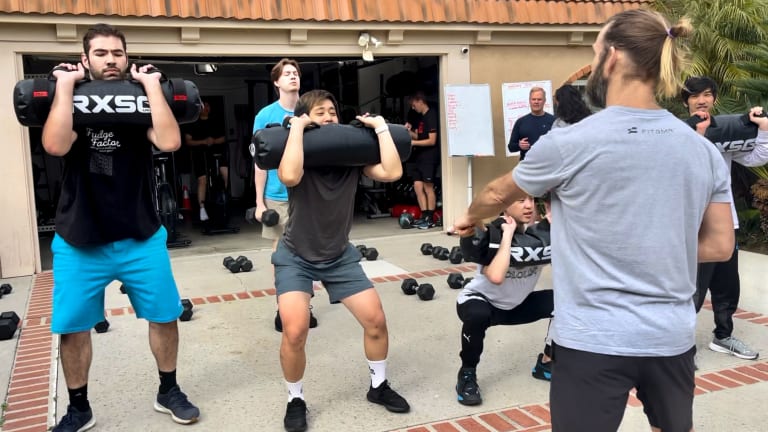
Esport Injuries Part 2 — The Invisible Killers

Now that we covered in Part 1 the injuries of the upper body that can happen to someone who basically just sits around most of the day as, e.g. a gamer, esports athlete or an officer worker, it is time to look into something that usually does not get mentioned when it comes to injuries. Although this is not truly an injury risk per se, and kind of falls just under the risk of being able to perform as a gamer, it’s still essential to understand these “invisible killer” risks:
Becoming overfat or obese, developing chronic (mainly cardiovascular) diseases, and falling into what is called the “metabolic syndrome”, which is not a disease by itself (1), but a collection of symptoms that are extremely bad signs for your health (2).
These signs include increased blood pressure, high blood sugar, excess body fat around the waist, and abnormal cholesterol or triglyceride levels (1,2). Now does this mean that the preconceived idea that gamers and esports athletes are mostly unhealthy and more likely to be struggling with these types of issues is true? Generally, the answer is no — and this is mainly due to the fact that worldwide population health has been decreasing continuously due to these symptoms and related chronic conditions (3). Gaming is definitely not causing a worldwide health pandemic! After almost 20 years in the field of health and wellbeing and 30 years in gaming, I can guarantee you that much.
Yet, to figure this out in more detail, and give you a better overview of how as a gamer or esports athlete you should definitely be aware of these invisible risks, we first have to look if gamers and esports athletes happen to show characteristics that are related to being less “healthy”. And this may not really appear as such a complex problem besides the fact that only recently there have been studies that have looked into these types of populations (as in us, the gamers), and barely for different age groups and levels of commitment to gaming (e.g. casual gamers, competitively motivated players, streamers, actual esports athletes). And as I always highlight how “details matter”, and because gaming in 2023 is such a large cultural phenomenon (4,5), we have to consider these different sub-populations when considering health characteristics.
Don't Believe the Stereotypes
When it comes generally to gamers, there have been several studies and surveys that have looked at basic anthropometric markers like BMI, self-reported physical activity, and the self-reported estimation of how healthy the gamers perceived themselves to be. These studies have overall shown that the results aren't as clear as the prejudiced image of a typical gamer seems to be.
On one side we have a survey that has been running for several years in Germany that shows that gamers are not doing that bad: more active than non-gamers (80% to 85% of all participants) and beating WHO recommendations by 4 to 6 hours per week, has a normal weight (based on BMI calculations), drinks enough water per day, and most of them rate their health great to excellent (over 80%) (6,7). Obviously, some of the results were negative, such as that 1 in 6 gamers goes late to bed due to gaming, 50% feel moderately stressed, 48.6% ignore their various physical pains, and scores only 55 to 60 out of 100 on mental wellbeing scales (that is rather low).
Similar findings were in Norwegian schools and esports athletes aged 17 to 21 years, who also had normal weight shown via BMI, and were also performing more physical activity than WHO recommendations with 1 to 2 hours 3 times per week (8). Thus, no difference between the average gamer to the more involved esports athlete? Not that fast. A large international study showed that on the positive side, esports players who were ranked higher (top 10% of the sample) were more physically active than other esports players — but unfortunately, generally, esports players in this study were less active than the general population (9). Yet, they also showed that they were more likely to be non-smokers (92% of the participants, NICE!), non-drinkers (65.1%), but unfortunately, they were either likely to be normal weight (like the previous data) or obesity class 2 and 3, the latter being the “morbid” one.
So gamers are a bit black and white, hey? Either they are ok, or really bad. Well, from here we go into the territory of somewhat mixed results because the available data sets are so scarce. About 40% of esports athletes at US colleges did not do any exercise at all, and only 2% of them who had any pains looked for medical help (10). Chinese mobile gamers showed similar physical activity where almost 50% had some sort of physical relaxation or recovery training after their esports games (although the details of what that constituted of are unclear) (11). This is all just confusing, isn’t it? I told you, there are simply not enough studies to make large-scale conclusions.
Making Large-Scale Conclusions
Yet, let me attempt some — obviously with the help of some smarter people than me from science. A collection of reviews (scientific summaries) on this area made some apt conclusions but always highlighted the scarce data availability, limited methodology of either small sample sizes, self-reporting methods, cross-sectional rather than longitudinal design and much more. Yet, they highlight that esports players in comparison to your average casual gamers are less likely to run into risks of overweight, obesity or lack of physical activity, but more likely to have reduced well-being through the likes of “reduced nutrition, caffeine supplementation, physiological arousal, injury, pain, stress, escapism or avoidance coping, cognitive fatigue, gaming addiction, mental ill-health, harassment, and racism” (12).
This could be further confirmed by another review looking at the connection of esports and physical activity where in 13 studies the esports athletes exceeded the WHO recommendations of 2.5 hours per week, and were low and inactive in 4 studies (13). Plus, the different subpopulations across studies had very different levels of activity. And finally, the higher levels they achieved in their games, the more active they were. Yet, the final take of two overviews highlighted some important warnings that I need to highlight as take-home messages (14,15): Psychological stress that can lead to cardiac arrhythmia (long-term changes to the rhythm of your heartbeat that are irreversible), and an increase in sympathetic tone (heartbeat is generally more “active” and slightly higher as if you are constantly in action mode).
Sleep deprivation (as mentioned before, shown to be likely for gamers and esports athletes) has major short- and long-term effects such as increased arterial stiffness and endothelial dysfunction (deterioration of your blood vessels), increased heart rate variability (increased chronic stress), increase in inflammatory markers, and the worst for last, left ventricular alterations and cardiac repolarization (bad structural and neural changes to your heart).
Stimulant overuse (energy drinks, coffee) increases pro-inflammatory levels of molecules that contribute to the development of diabetes and other metabolic diseases, prolongs the QT section of your heartbeat (bad change of heart rhythm), hyperplasia of your tunica intima (your blood vessels get tighter and have less space for blood flow), hypertension (high blood pressure), and also an overreliance on catecholamines (the stuff that makes you “awake” after drinking energy drinks).
And much more, all of which has led to now a second update on how to screen your esports athletes so that they can properly look after their health, well-being and fitness professionals, and perform better in the long-term for your team (15).
All in all, these together are understood as the cardiovascular sequelae (fancy word for an aftereffect of a disease, condition, or injury) of gaming and esports. There is definitely a difference between your average casual gamers and esports athletes, but that does not make you less likely to run into all of these invisible killers. Yes, these are somewhat independent of being a “gamer”, as we see a terribly scary trend of these conditions in the general population.
What Does It All Mean?
It still seems that if you are a gamer you are rolling the dice at a higher risk: you are even going to be ok, or it is going to be really really bad. Thus, let me in the last part of the series show you what you can effectively do to prevent these issues, but also how you can start doing something about them if you think you have any of it!
References:
1. Samson SL, Garber AJ. Metabolic syndrome. Endocrinol Metab Clin North Am. 2014 Mar;43(1):1–23.
2. McCracken E, Monaghan M, Sreenivasan S. Pathophysiology of the metabolic syndrome. Clin Dermatol. 2018;36(1):14–20.
3. Reilly JJ, El-Hamdouchi A, Diouf A, Monyeki A, Somda SA. Determining the worldwide prevalence of obesity. The Lancet. 2018 May 5;391(10132):1773–4.
4. Newzoo Global Games Market Report 2021 | Free Version [Internet]. Newzoo. [cited 2022 Sep 21]. Available from: https://newzoo.com/insights/trend-reports/newzoo-global-games-market-report-2021-free-version
5. Newzoo Global Games Market Report 2020 | Light Version [Internet]. Newzoo. [cited 2022 Sep 21]. Available from: https://newzoo.com/insights/trend-reports/newzoo-global-games-market-report-2020-light-version
6. Fact-Sheet-eSport-Studie-2021-scaled.jpg (JPEG Image, 1811 × 2560 pixels) — Scaled (36%) [Internet]. [cited 2022 Jun 14]. Available from: https://www.esportwissen.de/wp-content/uploads/2021/02/Fact-Sheet-eSport-Studie-2021-scaled.jpg
7. eSport-Studie-2020-FactSheet-scaled.jpg (JPEG Image, 1811 × 2560 pixels) — Scaled (36%) [Internet]. [cited 2022 Jun 14]. Available from: https://www.esportwissen.de/wp-content/uploads/2020/02/eSport-Studie-2020-FactSheet-scaled.jpg
8. Baumann A, Mentzoni RA, Erevik E, Pallesen S. A qualitative study on Norwegian esports students’ sleep, nutritional and physical activity habits and the link to health and performance. Int J Esports [Internet]. 2022 Aug 17 [cited 2022 Sep 12];2(2). Available from: https://www.ijesports.org/article/88/html
9. Trotter MG, Coulter TJ, Davis PA, Poulus DR, Polman R. The Association between Esports Participation, Health and Physical Activity Behaviour. Int J Environ Res Public Health. 2020 Oct 8;17(19):E7329.
10. DiFrancisco-Donoghue J, Balentine J, Schmidt G, Zwibel H. Managing the health of the eSport athlete: an integrated health management model. BMJ Open Sport Exerc Med. 2019 Jan 1;5(1):e000467.
11. Lam WK, Liu RT, Chen B, Huang XZ, Yi J, Wong DWC. Health Risks and Musculoskeletal Problems of Elite Mobile Esports Players: a Cross-Sectional Descriptive Study. Sports Med - Open. 2022 May 13;8(1):65.
12. Shulze J, Marquez M, Ruvalcaba O. The Biopsychosocial Factors That Impact eSports Players’ Well-Being: A Systematic Review. J Glob Sport Manag. 2021 Dec 9;0(0):1–25.
13. Are Esports Players Inactive? A Systematic Review [Internet]. [cited 2023 Jun 1]. Available from: https://sciendo.com/article/10.2478/pcssr-2022-0022
14. Yamagata K, Yamagata LM, Abela M. A review article of the cardiovascular sequalae in esport athletes: a cause for concern? Hellenic J Cardiol [Internet]. 2022 Jul 3 [cited 2022 Jul 27]; Available from: https://www.sciencedirect.com/science/article/pii/S1109966622000938
15. Rossoni A, Vecchiato M, Brugin E, Tranchita E, Adami PE, Bartesaghi M, et al. The eSports Medicine: Pre-Participation Screening and Injuries Management-An Update. Sports Basel Switz. 2023 Feb 1;11(2):34.





